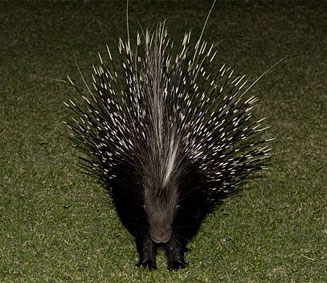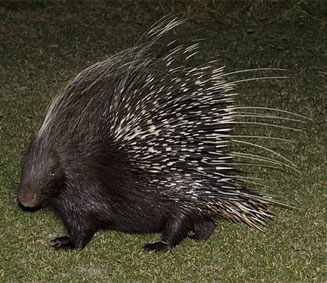|
Hystrix africaeaustralis (Cape porcupine)
porcupine, South African porcupine [English]; ystervark, Kaapse ystervark
[Afrikaans]; Süd-Afrika Stachelschwein [German];
porc-épique sud-Africain [French];
nnungu
[Swahili]; ingungubane, inungu [isiZulu] [siSwati]; noko [Sepedi] [Sesotho] [Setswana];
nungu [Xitsonga] [Tshivenda]; sinuku [Lozi]; unungu [Yei]; !Noab [Nama] [Damara]
Life
>
Eukaryotes >
Opisthokonta >
Metazoa (animals) > Bilateria > Deuterostomia >
Chordata > Craniata > Vertebrata (vertebrates) >
Gnathostomata (jawed vertebrates) > Teleostomi (teleost
fish) > Osteichthyes (bony fish) > Class:
Sarcopterygii (lobe-finned fish) > Stegocephalia
(terrestrial vertebrates) > Reptiliomorpha > Amniota >
Synapsida (mammal-like reptiles) > Therapsida > Theriodontia
> Cynodontia > Mammalia (mammals)
> Placentalia (placental mammals) >
Euarchontaglires > Glires > Rodentia (rodents) > Hystricognathi
> Family: Hystricidae (porcupines)
 |
 |
|
Hystrix africaeaustralis (Cape porcupine),
Rooipoort Nature Reserve, South Africa. [photos Trevor Hardaker ©] |
Identification
The porcupine is the largest rodent in southern
Africa. It has a distinctive appearance with its protective body
covering of long rigid quills and flexible spines, banded in black
and white. A crest of erectile long coarse hairs runs from the top
of the head along the neck to the shoulder. The crest is raised with
the quills when the animal is alarmed or angry. The head and snout
are broad, with small rounded ears and small eyes. The legs are
short and stoutly built, with heavily clawed feet. The short tail is
surrounded by a number of short, hollow and open-ended quills. These
produce a characteristic rattling when the tail is shaken, serving
as a warning.
Size
Body length 75 - 100 cm; weight range 10 - 24 kg
Dental formula
I C C P P M M =
20 =
20
Distribution and habitat
Widely distributed in South Africa, preferring woodlands,
savannas, grassland and semi-desert.
General behaviour
Porcupines live in extended family groups including both
parents and their young of several years. Each group has a distinct territory.
As they are active at night, they require shelter during the day and a family
group may occupy a burrow system. They also use crevices in rocks, in caves and
abandoned aardvark holes which they modify by further digging. Well-used
porcupine shelters often have an accumulation of gnawed bones in the immediate
vicinity. It is thought that gnawing bones helps to sharpen the large
chisel-like incisors and supplement their diet with minerals.
When alarmed, porcupines erect their crest and quills,
stamp their hind feet and rattle their quills and make a grunting noise. If the
threat continues they turn their rump towards it and defend themselves by
running either sideways or backwards into the enemy. On contact the quills
easily detach, and may penetrate the skin of the threatening animal. It is often
believed that porcupines can “shoot” quills backwards but this is not true.
Food
They eat a bulbs, tubers, roots and the bark from trees, as
well as some cultivated crops e.g. maize, potatoes and pumpkins. They have also
been recorded eating from animal carcasses and gnawing on bones.
Reproduction
- Usually one litter is born a year, with an average litter
size of 1 -3 young.
- The gestation period is 93 - 94 days long.
- The young are well-developed at birth, with short spines and
open eyes. They remain in the burrow for the first nine weeks and eat solid food
after about 4 weeks. Offspring may remain with the family group for extended
periods and females that remain with the family group will not reproduce.
Dispersal to a new area is required before they become reproductively active.
Life span
12-15 years
Conservation
Currently porcupines are not threatened but do come into
conflict with crop-producing farmers and gardeners. They benefit from the
absence of their natural predators (lion, hyaena, leopards) over most of their
range and may also have benefited from the increase in the production of
agricultural crops. Porcupines are destroyed by a variety of methods, and are
regarded as good eating by indigenous people. More recently porcupine quills
have become sort after both as components of ornamental jewellery and décor
items. There is concern that the populations will not be able to sustain the
pressure of hunting to supply this demand. Local conservation agencies are
beginning to try to assess the impact.
|
